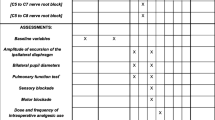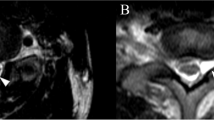Abstract
Background
Animal experiments have shown that one of the pathways for pain originating from the cervical spine is the sympathetic trunk. However, there have been few reports regarding the cervical pain pathway and efficacy of interscalene brachial plexus block for upper limb, scapular and chest pain originating in the cervical spine in clinical cases. The purpose of the present study was to clarify the efficacy of interscalene brachial plexus block for upper limb, scapular and chest pain.
Methods
Patients (137 men and 223 women) who had cervical radicular pain were studied. The intensity of upper limb, scapular and chest pain was measured by using a VAS before injection and at 5 min and 7 days after injection. To evaluate the efficacy of interscalene brachial plexus block, patients with cervical radicular pain who had received NSAIDs for at least 2 weeks were randomized to interscalene brachial plexus block or control block groups. VAS scores were compared to assess the effects of injection and the pain pathway.
Results
The average VAS score for upper limb pain with or without scapular and chest pain was significantly reduced by interscalene brachial plexus block compared with control block at 5 min and 7 days after injection. After interscalene brachial plexus block, 89 patients reported symptoms of stellate ganglion block versus no patients after control block. Scapular and chest pain was significantly reduced in the patients with stellate ganglion block compared to those without stellate ganglion block.
Conclusions
Interscalene brachial plexus block is useful for upper limb, scapular and chest pain due to disorders of the cervical spine. The scapular and chest pain pathway is more likely to be interrupted by an interscalene brachial plexus block that causes a stellate ganglion block compared to an interscalene brachial plexus block without stellate ganglion block.






Similar content being viewed by others
References
Schellhas K, Smith M, Gundry CR, Pollei SR. Cervical discogenic pain: prospective correlation of magnetic resonance imaging and discography in asymptomatic subjects and pain sufferers. Spine. 1996;21:300–11.
Foerster O. The dermatomes in man. Brain. 1933;56:1–39.
Ammons WS. Characteristics of spinoreticular and spinothalamic neurons with renal input. J Neurophysiol. 1987;58:480–95.
Cervero F, Connell LA, Lawson SN. Somatic and visceral primary afferents in the lower thoracic dorsal root ganglia of the cat. J Comp Neurol. 1984;228:422–31.
Cervero F, Tattersall JE. Cutaneous receptive fields of somatic and viscerosomatic neurones in the thoracic spinal cord of the cat. J Comp Neurol. 1985;237:325–32.
Ruch TC. Pathophysiology of pain. In: Fulton JF, editor. A textbook of physiology. 17th ed. Philadelphia: WB Saunders; 1955. p. 358–76.
Yokota T, Koyama N, Nishikawa Y, Hasegawa A. Dual somatosensory representation of the periodontium in nucleus ventralis posteromedialis of the cat thalamus. Brain Res. 1988;475:187–91.
Ikeda Y, Lee M, Ebata T, Ogasawara A. Application of interscalene brachial plexus block for upper extremity and shoulder girdle pain. Seikeigeka. 1993;44:1871–4.
Murakami H, Lee M, Mimura M, Ohtake Y, Ikeda Y. Application of interscalene brachial plexus block for cervical spondylotic radiculopathy. 1997;48:1191–94.
Winnie AP. Interscalene brachial plexus block. Anesth Analg. 1970;49:455–66.
Ohtori S, Takahashi K, Chiba T, Yamagata M, Sameda H, Moriya H. Sensory innervation of the cervical facet joints in rats. Spine. 2001;26:147–50.
Coleman MM, Chan VW. Continuous interscalene brachial plexus block. Can J Anaesth. 1999;46(3):209–14.
Liguori GA, Zayas VM, YaDeau JT, Kahn RL, Paroli L, Buschiazzo V, Wu A. Nerve localization techniques for interscalene brachial plexus blockade: a prospective, randomized comparison of mechanical paresthesia versus electrical stimulation. Anesth Analg. 2006;103:761–7.
Cloward RB. Cervical diskography: a contribution to the etiology and mechanism of neck, shoulder and arm pain. Ann Surg. 1959;150:1052–64.
Dwyer A, Aprill C, Bogduk N. Cervical zygapophyseal joint pain patterns I: a study in normal volunteers. Spine. 1990;15:453–7.
Fukui S, Ohseto K, Shiotani M, Ohno K, Karasawa H, Naganuma Y, Yuda Y. Referred pain distribution of the cervical zygapophyseal joints and cervical dorsal rami. Pain. 1996;68:79–83.
Grubb SA, Kelly CK. Cervical discography: clinical implications from 12 years of experience. Spine. 2000;25:1382–9.
Slipman CW, Plastaras C, Patel R, Isaac Z, Chow D, Garvan C, Pauza K, Furman M. Provocative cervical discography symptom mapping. Spine J. 2005;5:381–8.
Malmqvist EL, Bengtsson M, Sorenson J. Efficacy of stellate ganglion block: a clinical study with bupivacaine. Reg Anesth. 1992;17:340–7.
Matsumoto S. Thermographic assessments of the sympathetic blockade by stellate ganglion (1): comparison between C7-SGB and C6-SGB in patients. Masui. 1991;40:562–9.
Mastsumoto S. Thermographic assessment of the sympathetic blockade by stellate ganglion block (20): comparison between C7-SGB and C6-SGB in 20 healthy volunteers. Masui. 1991;40:692–701.
Wilkinson H. Percutaneous radiofrequency, upper thoracic sympathectomy. New technique. Neurosurgery. 1984;15:811–4.
Wilkinson H. Neurosurgical procedures of the sympathetic nervous system. Pain Clin. 1995;1:43–50.
Parent A. Autonomic nervous system. In: Carpenter’s human neuroanatomy. 9th ed. Media: Wiliams & Wilkins; 1996. p. 293–320.
Standring S. Antomic nervous system. In: Gray’s anatomy. 40th ed. London: Churchill Livingstone; 2009. p. 232–6.
McDonald JS, Pensak ML, Phero JC. Part II: thoughts on the management of chronic facial, head, and neck pain. Am J Oncol. 1990;11:378–82.
Hogan QH, Abram SE. Neural blockade for diagnosis and prognosis: a review. Anesthesiology. 1997;86:216–41.
Uchida K, Tateda T, Hino H. Novel mechanism of action hypothesized for stellate ganglion block related to melatonin. Med Hypotheses. 2002;59:446–9.
Conflict of interest
The authors declare that they have no conflict of interest.
Author information
Authors and Affiliations
Corresponding author
About this article
Cite this article
Murata, Y., Kanaya, K., Wada, H. et al. Interscalene brachial plexus block for scapular and upper chest pain due to cervical radiculopathy: a randomized controlled clinical trial. J Orthop Sci 17, 515–520 (2012). https://doi.org/10.1007/s00776-012-0248-2
Received:
Accepted:
Published:
Issue Date:
DOI: https://doi.org/10.1007/s00776-012-0248-2




